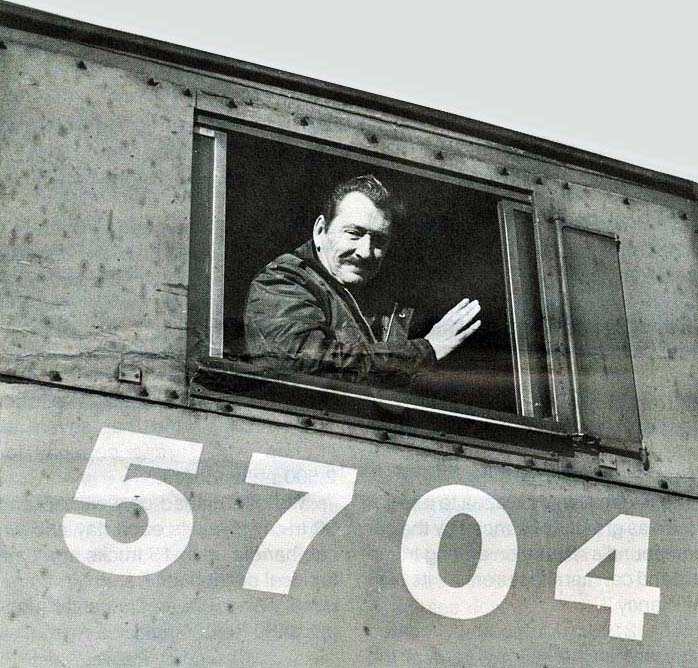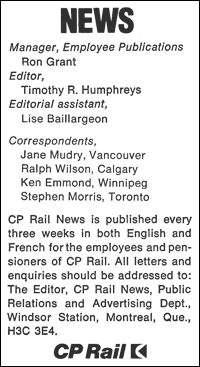
Number 7
May 25, 1983
Exibits Many Talents

and on a ship as he is in the cab of 5704. He's quite a resourceful handyman too.
By LEN COCOLICCHIO - If you need an air conditioner, washer, refrigerator, or radio repaired, if your car engine has seized or the generator is on the blink, if your pocket watch is running fast or its spring has sprung, or you simply have a locomotive to move a few hundred miles, an ex-seaman, former airman, and now a CP Rail locomotive engineer, Al Ruttan can offer his expert and sundry services.
There's a 1965 Caddy sitting at awkward angle in the driveway to Al's Revelstoke, B.C. house. Yesterday, Al pulled apart the engine. Today, he plans to put it back in one piece.
"When I bought it seven years ago, it had been sitting in a shed for seven years," he says. "The compression was down in one cylinder and the old man who owned it couldn't get what he thought it was worth on a trade-in. So he left it in his barn."
There are three other cars jammed into the driveway and onto the lawn, each in varying states of repair, or disrepair. Another 11 cars are sitting on another piece of Al's property.
He's reduced his inventory considerably from the day in 1961 when he bought 100 cars. "They had been impounded by the city of Calgary. They cost $8 a piece, so I bought them and sold all 100 for scrap at $52 each."
If Al appears something of a horse trader in horsepower, that shouldn't reflect on any of his other interests, which, he readily admits, have been somewhat less financially successful.
REAL PASSION
In 1957, Al left the railway to open an appliance and refrigeration service and sales business. "When I closed shop in 1963, 1 had a stack of unpaid invoices this thick," he says, leaving a gap of about two inches between greasy thumb and forefinger. He returned to CP Rail.
His real passion, however, is time pieces. And in this, he says, he is inventory rich and cash poor.
Al has sold no more than a dozen pocket watches and three clocks over the last 28 years. Not that he hasn't enough to part with a few. An alcove off the living-room is the somewhat chaotic looking home to a few dozen clocks, most of them antique. Some are ticking, others are in need of a balance, a face, a spring, even a casing.
There are minute bolts and screws scattered on a tabletop, a shoebox full of springs, levers, and rings. And a desk drawer with pocket watches needing one part or another.
There's more upstairs, he says... and downstairs.
"I know where every piece is," he assures an obviously skeptical observer. "In fact, if anybody ever organized this mess, I'd probably never find anything."
Al worked as a wiper for CP Rail after leaving the navy following the Second World War. In 1952, he decided to return to military life, this time the air force. Why the change? "You've heard the saying, men of the army, men of the navy, gentlemen of the air force."
He worked as an instrument electrical mechanic and during this time one of the reserves, who was a watchmaker, offered to teach him the trade.
Al has a collection of pocket watches that dates to the 1760s. His oldest is the English Verge fusee, a time movement invented in the 10th century which went unchanged for 900 years. The verge fusee was similar to a pendulum movement on a wall clock. A spindle would swing back and forth, advancing two-and-a-half teeth, or verges, per second. Then, in the early 1800s, a dentist revolutionized the watch making industry with his invention of the lever escapement, making the verge obsolete.
Al has a pocket watch from every era. There's the Credenza, 1772 to 1776, a rail grade movement by Elgin, using the veritas movement, the best ever made by Elgin. "They used gem quality stones, diamond capped jewel, gold weights. It doesn't keep any better time than a B.W. Raymond, but the diamond and gold made it more valuable," he says.
He has a "goofy little Rolex pocket watch," circa 1920, purchased from a coin and stamp dealer.
Al says the great inventions in time pieces were made by the British. But the industry had to move to the United States to advance. The best pocket watches are American-made and Swiss superiority is a myth, he states categorically.
He says the Swiss can claim credit or more accurately "responsibility", for mass production of watches, but not to technological perfection.
If necessity is the mother of invention, then the railway industry can lay claim to some important off-spring, so to speak, in time-keeping accuracy.
RULE OF INVENTION
 "In the 19th century, it
was up to the locomotive engineer and the conductor to arrive at a time on the time card," explains Al. "Their watches were often out
and the result was train accidents.
"In the 19th century, it
was up to the locomotive engineer and the conductor to arrive at a time on the time card," explains Al. "Their watches were often out
and the result was train accidents.
"So in the 1870s, Waltham produced a rail grade watch using better materials to stop the expansion and contraction that was causing poor accuracy. Elgin, the biggest watchmaker, got frantic. They produced a watch that, after 100 years, has an error of two seconds a day."
The same rule of invention applies to Al's workshop. He has two lathes and "a box full of junk I can make parts out of." A piece of coat hanger, he points out, makes a great balance staff.
There are other ways to get parts, too. Like the time he approached the manager of a national jewelry chain store.
"He gave me a shoe box full of used parts, they don't want to ruin the new watch market by selling used ones."
The price, coffee for the employees for a week.

